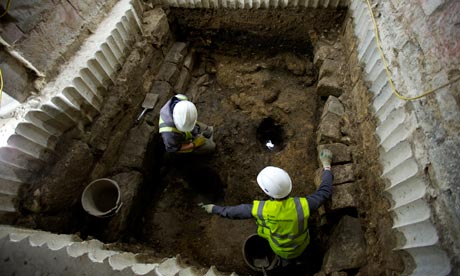What happened after the Romans left and the Vikings of Jorvik arrived? Two post holes and a jumble of bones may hold a clue

Field archaeologists Ian Milsted and Jim
Williams in the dig site at York Minster that hints at Saxon remains.
Photograph: Christopher Thomond for the Guardian
When the great west doors of York Minster swing open on Thursday
and the Queen makes her way along the nave of the packed church for the
ancient service of distributing Maundy Money, she will also be walking
towards a small pit from which human bones have been pouring by the
barrow load, the remains of some of the earliest Christians to worship
on the site.
Tantalising finds include 30 skulls and a jumble of
bones used to backfill a trench by the medieval builders of the present
cathedral, and a man whose stone-lined and lidded grave was chopped off
by Walter de Gray's 13th-century walls, leaving only his shins and feet
in place.
Potentially the most significant finds are two
nondescript round holes, with groundwater bubbling up through the mud.
They are post holes that could date from the time of the earliest
Christian church on the site, after the Roman empire disintegrated in
the 5th century and before raiding Vikings arrived in the 8th century
and the Normans in the 11th century.

